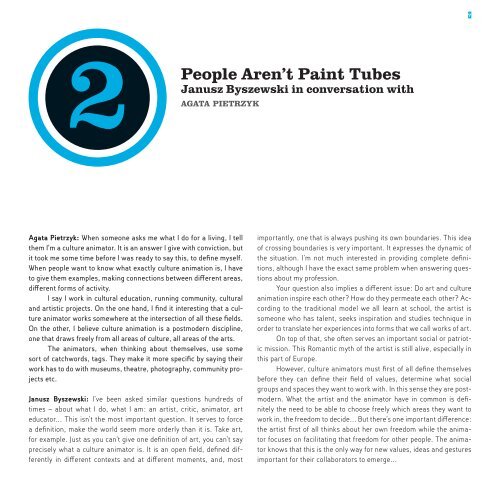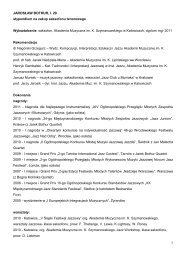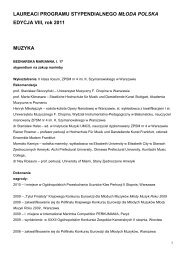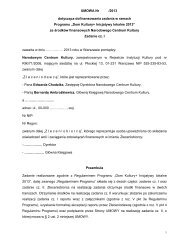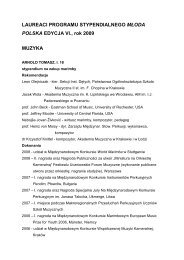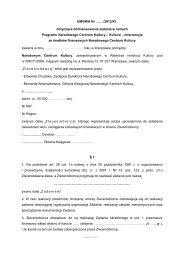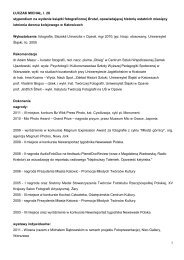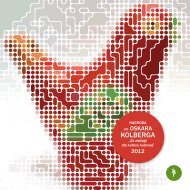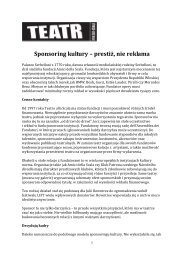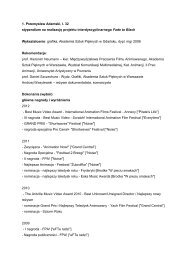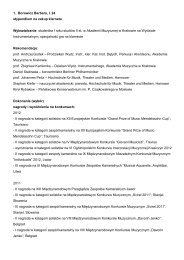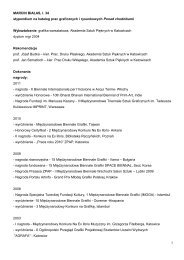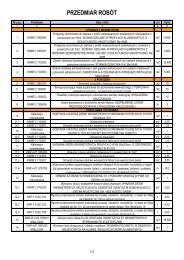Untitled - Narodowe Centrum Kultury
Untitled - Narodowe Centrum Kultury
Untitled - Narodowe Centrum Kultury
Create successful ePaper yourself
Turn your PDF publications into a flip-book with our unique Google optimized e-Paper software.
tytuł artykułu 7<br />
2<br />
People<br />
Aren’t Paint Tubes<br />
Janusz Byszewski in conversation with<br />
agata pietrzyk<br />
Agata Pietrzyk: When someone asks me what I do for a living, I tell<br />
them I’m a culture animator. It is an answer I give with conviction, but<br />
it took me some time before I was ready to say this, to define myself.<br />
When people want to know what exactly culture animation is, I have<br />
to give them examples, making connections between different areas,<br />
different forms of activity.<br />
I say I work in cultural education, running community, cultural<br />
and artistic projects. On the one hand, I find it interesting that a culture<br />
animator works somewhere at the intersection of all these fields.<br />
On the other, I believe culture animation is a postmodern discipline,<br />
one that draws freely from all areas of culture, all areas of the arts.<br />
The animators, when thinking about themselves, use some<br />
sort of catchwords, tags. They make it more specific by saying their<br />
work has to do with museums, theatre, photography, community projects<br />
etc.<br />
Janusz Byszewski: I’ve been asked similar questions hundreds of<br />
times – about what I do, what I am: an artist, critic, animator, art<br />
educator... This isn’t the most important question. It serves to force<br />
a definition, make the world seem more orderly than it is. Take art,<br />
for example. Just as you can’t give one definition of art, you can’t say<br />
precisely what a culture animator is. It is an open field, defined differently<br />
in different contexts and at different moments, and, most<br />
importantly, one that is always pushing its own boundaries. This idea<br />
of crossing boundaries is very important. It expresses the dynamic of<br />
the situation. I’m not much interested in providing complete definitions,<br />
although I have the exact same problem when answering questions<br />
about my profession.<br />
Your question also implies a different issue: Do art and culture<br />
animation inspire each other How do they permeate each other According<br />
to the traditional model we all learn at school, the artist is<br />
someone who has talent, seeks inspiration and studies technique in<br />
order to translate her experiences into forms that we call works of art.<br />
On top of that, she often serves an important social or patriotic<br />
mission. This Romantic myth of the artist is still alive, especially in<br />
this part of Europe.<br />
However, culture animators must first of all define themselves<br />
before they can define their field of values, determine what social<br />
groups and spaces they want to work with. In this sense they are postmodern.<br />
What the artist and the animator have in common is definitely<br />
the need to be able to choose freely which areas they want to<br />
work in, the freedom to decide... But there’s one important difference:<br />
the artist first of all thinks about her own freedom while the animator<br />
focuses on facilitating that freedom for other people. The animator<br />
knows that this is the only way for new values, ideas and gestures<br />
important for their collaborators to emerge...


